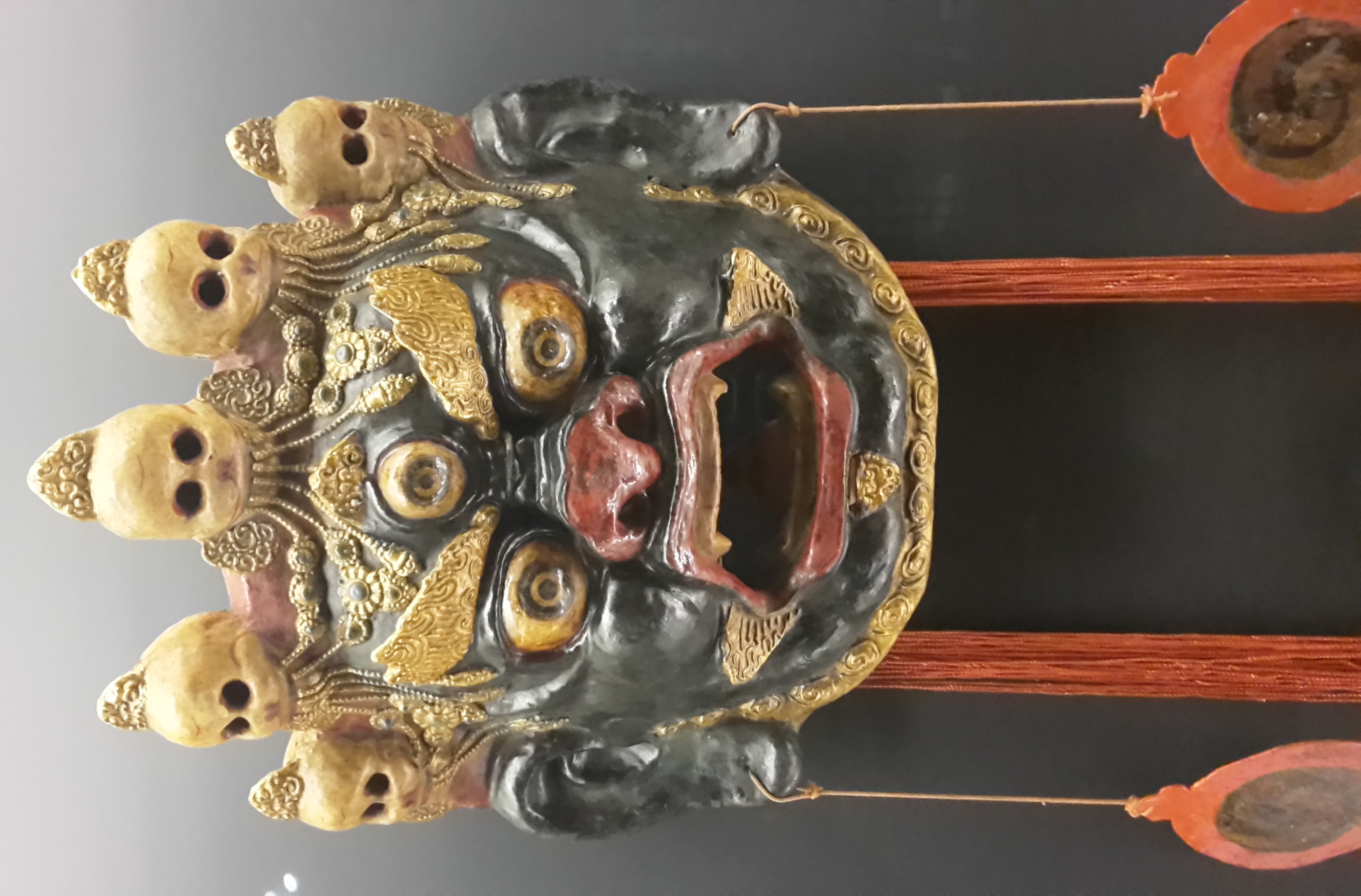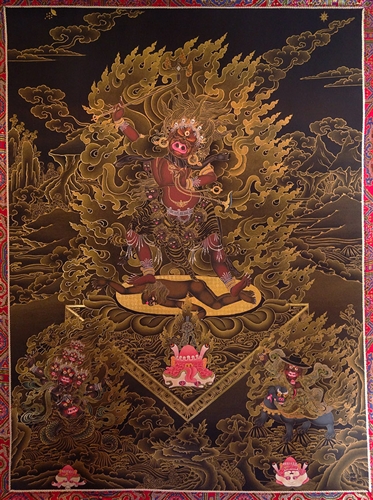|
Dharmapala
A ''dharmapāla'' (, , ja, 達磨波羅, 護法善神, 護法神, 諸天善神, 諸天鬼神, 諸天善神諸大眷屬) is a type of wrathful god in Buddhism. The name means "'' dharma'' protector" in Sanskrit, and the ''dharmapālas'' are also known as the Defenders of the Justice (Dharma), or the Guardians of the Law. There are two kinds of ''dharmapala'', Worldly Guardians (''lokapala'') and Wisdom Protectors (''jnanapala''). Only Wisdom Protectors are enlightened beings. Description A protector of Buddhist dharma is called a ''dharmapala''. They are typically wrathful deities, depicted with terrifying iconography in the Mahayana and tantric traditions of Buddhism. The wrathfulness is intended to depict their willingness to defend and guard Buddhist followers from dangers and enemies. The '' Aṣṭagatyaḥ'' (the eight kinds of nonhuman beings) is one category of ''dharmapālas'', which includes the Garuda, Deva, Naga, Yaksha, Gandharva, Asura, Kinnara and Mahora ... [...More Info...] [...Related Items...] OR: [Wikipedia] [Google] [Baidu] |
Palden Lhamo
Palden Lhamo ("Glorious Goddess",Volkmann, Rosemarie: "Female Stereotypes in Tibetan Religion and Art: the Genetrix/Progenitress as the Exponent of the Underworld" ''in'' , sa, Śrīdēvī, mn, Ukin Tengri) or RematiDowman, Keith. (1988). ''The Power-Places of Central Tibet: The Pilgrim's Guide'', p. 260. Routledge & Kegan Paul Ltd., London. (pbk). are names of Shri Devi, a female tantric Buddhist deity who appears in dozens of different forms.https://www.himalayanart.org/search/set.cfm?setID=164 Shri Devi Main Page at Himalayan Art Resources She usually appears as a wrathful deity with a primary role as a dharmapala. She is specifically a Wisdom Protector, an enlightened being. Palden Lhamo is one of three Dharmapalas of the Gelug school of Tibetan Buddhism alongside Mahākāla and Yamantaka She is the wrathful deity considered to be the principal protectress of Bhutan. Palden Lhamo appears in the retinue of the Obstacle-Removing Mahākāla, either as an independent figu ... [...More Info...] [...Related Items...] OR: [Wikipedia] [Google] [Baidu] |
Mahakala
Mahākāla is a deity common to Hinduism and Tantric Buddhism. In Buddhism, Mahākāla is regarded as the sacred '' Dharmapāla'' ("Protector of the Dharma"), while in Hinduism, Mahākāla is a fierce manifestation of the Hindu god Shiva and the consort of the goddess Mahākālī; he most prominently appears in the ''Kalikula'' sect of Shaktism. Mahākāla also appears as a protector deity in Vajrayana, Chinese Esoteric, and Tibetan Buddhism (see Citipati), and also in the Chàn and Shingon traditions. He is known as ''Dàhēitiān'' and '' Daaih'hāktīn'' ( 大黑天) in Mandarin and Cantonese, ''Daeheukcheon'' (대흑천) in Korean, ''Đại Hắc Thiên'' in Vietnamese, and '' Daikokuten'' ( 大黒天) in Japanese. Etymology is a Sanskrit bahuvrihi of ' "great" and ' "time/death", which means "beyond time" or death. means "Great Black One". "Protector" is also used to refer specifically to Mahākāla. Description According to ''Shaktisamgama Tantra'', the spous ... [...More Info...] [...Related Items...] OR: [Wikipedia] [Google] [Baidu] |
Yama (Buddhism And Chinese Mythology)
In East Asian and Buddhist mythology, Yama () or King Yan-lo/Yan-lo Wang (), also known as King Yan/Yan Wang (), Grandfatherly King Yan (), Lord Yan (), and Yan-lo, Son of Heaven (), is the King of Hell and a dharmapala (wrathful god) said to judge the dead and preside over the Narakas and the cycle of afterlife saṃsāra. Although based on the god Yama of the Hindu Vedas, the Buddhist Yama has spread and developed different myths and different functions from the Hindu deity. He has also spread far more widely and is known in most countries where Buddhism is practiced, including China, Korea, Japan, Taiwan, Vietnam, Bhutan, Mongolia, Thailand, Sri Lanka, Cambodia, Myanmar and Laos. In Theravāda Buddhism In the Pali canon, the Buddha states that a person who has ill-treated their parents, ascetics, holy persons, or elders is taken upon his death to Yama. Yama then asks the ignoble person if he ever considered his own ill conduct in light of birth, deterioration, sicknes ... [...More Info...] [...Related Items...] OR: [Wikipedia] [Google] [Baidu] |
Begtse
Begtse (; "Begtse the Great Coat of Mail") is a dharmapala and the lord of war in Tibetan Buddhism, originally a pre-Buddhist war god of the Mongols. Name The name Begtse () is a loanword from Mongolian , meaning "coat of mail". He is also given the name and epithet Jamsaran (), meaning "Great Coat of Mail", which is a translation of the Mongolian. Description Begtse has red skin and orange-red hair, two arms (as opposed to other Mahākālas, who have four or six), three blood-shot eyes and is wielding a sword in his right hand. He also holds a human heart in his right hand. In the stock of his right arm, he holds a bow and arrow and a halberd with bannet. He wears a chainmail shirt, which gave rise to his name, ''Jamsaran''. He wears a Mongolian helmet with a crown of five skulls and four banners in the back. He is also accompanied by his consort, Rikpay Lhamo, and his main general, Laihansorgodog. They are surrounded by Jamsaran's satellites, the twenty-nine butchers. Cul ... [...More Info...] [...Related Items...] OR: [Wikipedia] [Google] [Baidu] |
Bodhisattva
In Buddhism, a bodhisattva ( ; sa, 𑀩𑁄𑀥𑀺𑀲𑀢𑁆𑀢𑁆𑀯 (Brahmī), translit=bodhisattva, label=Sanskrit) or bodhisatva is a person who is on the path towards bodhi ('awakening') or Buddhahood. In the Early Buddhist schools as well as modern Theravada Buddhism, a bodhisattva ( Pali: ''bodhisatta'') refers to someone who has made a resolution to become a Buddha and has also received a confirmation or prediction from a living Buddha that this will be so. In Mahayana Buddhism, a bodhisattva refers to anyone who has generated '' bodhicitta'', a spontaneous wish and compassionate mind to attain Buddhahood for the benefit of all sentient beings. Mahayana bodhisattvas are spiritually heroic persons that work to attain awakening and are driven by a great compassion (''mahakaruṇā''). These beings are exemplified by important spiritual qualities such as the "four divine abodes" ('' brahmaviharas'') of loving-kindness (''metta''), compassion ('' karuṇā''), emp ... [...More Info...] [...Related Items...] OR: [Wikipedia] [Google] [Baidu] |
Yamantaka
Yamāntaka ( sa, यमान्तक Yamāntaka) or Vajrabhairava (; ; ko, 대위덕명왕 ''Daewideok-myeongwang''; ja, 大威徳明王 ''Daiitoku-myōō''; mn, Эрлэгийн Жаргагчи ''Erlig-jin Jarghagchi'') is the "destroyer of death" deity of Vajrayana Buddhism. Sometimes he is conceptualized as "conqueror of the lord of death". Of the several deities in the Buddhist pantheon named 'Yamāntaka', the most well known, also called as 'Vajrabhairava' belongs to the Anuttarayoga Tantra class of deities popular within the Gelug school of Tibetan Buddhism. Etymology ''Yamāntaka'' is a Sanskrit name that can be broken down into two primary elements: ''Yama (यम)'', –the god of death; and ''antaka'' (अन्तक) –destroyer. Thus, Yamāntaka means “Destroyer of Death” or "Conqueror of Death". While Yamāntaka is therefore Yama's nemesis, his representation mirrors Yama in many ways: he too often rides a buffalo and often depicted with a buffalo's head ... [...More Info...] [...Related Items...] OR: [Wikipedia] [Google] [Baidu] |
Vajrayana
Vajrayāna ( sa, वज्रयान, "thunderbolt vehicle", "diamond vehicle", or "indestructible vehicle"), along with Mantrayāna, Guhyamantrayāna, Tantrayāna, Secret Mantra, Tantric Buddhism, and Esoteric Buddhism, are names referring to Buddhist traditions associated with Tantra and "Secret Mantra", which developed in the medieval Indian subcontinent and spread to Tibet, Nepal, other Himalayan states, East Asia, and Mongolia. Vajrayāna practices are connected to specific lineages in Buddhism, through the teachings of lineage holders. Others might generally refer to texts as the Buddhist Tantras. It includes practices that make use of mantras, dharanis, mudras, mandalas and the visualization of deities and Buddhas. Traditional Vajrayāna sources say that the tantras and the lineage of Vajrayāna were taught by Śākyamuni Buddha and other figures such as the bodhisattva Vajrapani and Padmasambhava. Contemporary historians of Buddhist studies meanwhile argue that ... [...More Info...] [...Related Items...] OR: [Wikipedia] [Google] [Baidu] |
Ekajati
Ekajaṭī or Ekajaṭā (Sanskrit: "One Plait Woman"; : one who has one knot of hair), also known as Māhacīnatārā,''The Alchemical Body: Siddha Traditions in Medieval India'' By David Gordon White. pg 65 is one of the 21 Taras. Ekajati is one of the most powerful and fierce protectors of Vajrayana Buddhist mythology. According to Tibetan legends, her right eye was pierced by the tantric master Padmasambhava so that she could much more effectively help him subjugate Tibetan demons. Ekajati is also known as "Blue Tārā", "Black Tārā", "Vajra Tārā" or "Ugra Tārā". She is generally considered one of the three principal protectors of the Nyingma school along with Rāhula and Vajrasādhu (). Often Ekajati appears as liberator in the mandala of the Green Tara. Along with that, her ascribed powers are removing the fear of enemies, spreading joy, and removing personal hindrances on the path to enlightenment. Ekajati is the protector of secret mantras and "as the mother o ... [...More Info...] [...Related Items...] OR: [Wikipedia] [Google] [Baidu] |
Prajñā (Buddhism)
Prajñā (Sanskrit: प्रज्ञा) or paññā (Pāli: पञ्ञा), is a Buddhist term often translated as "wisdom", "intelligence", or "understanding". It is described in Buddhist texts as the understanding of the true nature of phenomena. In the context of Buddhist meditation, it is the ability to understand the three characteristics of all things: ''anicca'' ("impermanence"), '' dukkha'' ("dissatisfaction" or "suffering"), and ''anattā'' ("non-self"). Mahāyāna texts describe it as the understanding of ''śūnyatā'' ("emptiness"). It is part of the Threefold Training in Buddhism, and is one of the ten '' pāramīs'' of Theravāda Buddhism and one of the six Mahāyāna ''pāramitās''. Etymology ''Prajñā'' () is often translated as "wisdom", but according to Buddhist bioethics scholar Damien Keown, it is closer in meaning to "insight", "non-discriminating knowledge", or "intuitive apprehension". * ''jñā'' () can be translated as "consciousness", "knowl ... [...More Info...] [...Related Items...] OR: [Wikipedia] [Google] [Baidu] |
Manjushri
Mañjuśrī (Sanskrit: मञ्जुश्री) is a ''bodhisattva'' associated with '' prajñā'' (wisdom) in Mahāyāna Buddhism. His name means "Gentle Glory" in Sanskrit. Mañjuśrī is also known by the fuller name of Mañjuśrīkumārabhūta (),Keown, Damien (editor) with Hodge, Stephen; Jones, Charles; Tinti, Paola (2003). ''A Dictionary of Buddhism.'' Oxford, UK: Oxford University Press. p.172. literally "Mañjuśrī, Still a Youth" or, less literally, "Prince Mañjuśrī". Another name of Mañjuśrī is Mañjughoṣa. It is claimed that Nurhaci, the founder of what would become the Qing dynasty of China, named his tribe Man (满) after Manjushri. In Mahāyāna Buddhism Scholars have identified Mañjuśrī as the oldest and most significant bodhisattva in Mahāyāna literature. Mañjuśrī is first referred to in early Mahāyāna sūtras such as the Prajñāpāramitā ''sūtra''s and through this association, very early in the tradition he came to symbolize th ... [...More Info...] [...Related Items...] OR: [Wikipedia] [Google] [Baidu] |
Genius Loci
In classical Roman religion, a ''genius loci'' (plural ''genii locorum'') was the protective spirit of a place. It was often depicted in religious iconography as a figure holding attributes such as a cornucopia, patera ( libation bowl) or snake. Many Roman altars found throughout the Western Roman Empire were dedicated to a particular ''genius loci''. The Roman imperial cults of the Emperor and the imperial house developed in part in connections with the sacrifices made by neighborhood associations ''( vici)'' to the local ''genius''. These 265 local districts had their cult organised around the ''Lares Compitales'' (guardian spirits or '' lares'' of the crossroads), which the emperor Augustus transformed into ''Lares Augusti'' along with the ''Genius Augusti''. The emperor's '' genius'' is then regarded as the ''genius loci'' of the Roman Empire as a whole. Roman examples of these ''genii'' can be found, for example, at the church of St. Giles, Tockenham, Wiltshire where th ... [...More Info...] [...Related Items...] OR: [Wikipedia] [Google] [Baidu] |


_by_Lu_Xinzhong.jpg)


_(8697431158).jpg)


